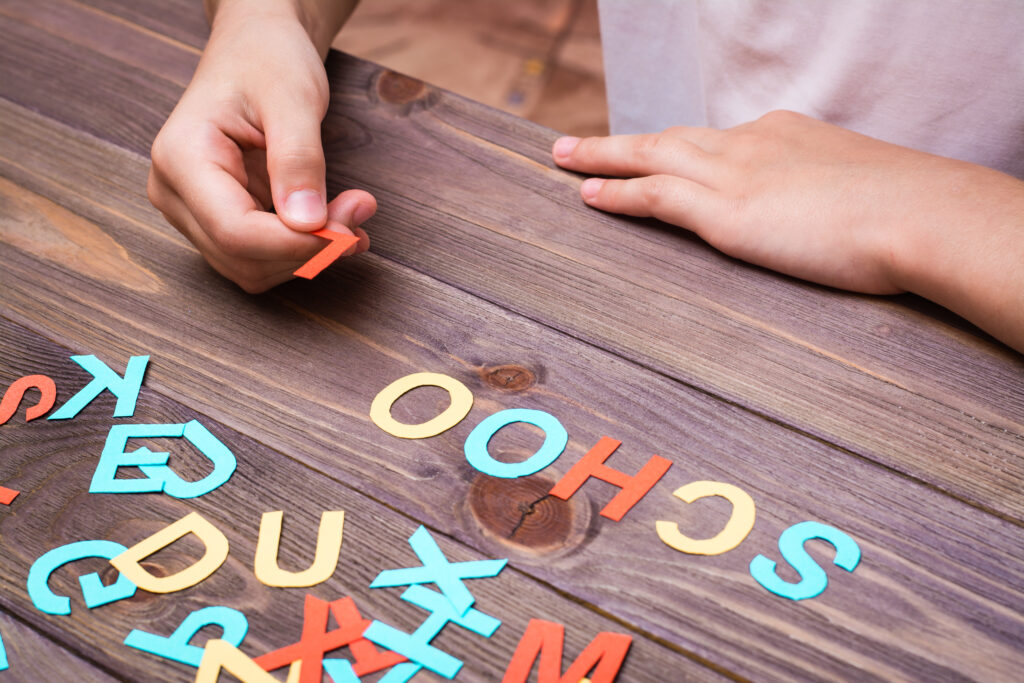Dyslexia Definition
Dyslexia is most commonly related to difficulties with reading, spelling and writing, affecting the ability to recognise and use sounds. Dyslexic kids may have difficulty decoding new words or breaking them down into smaller parts so they can sound them out. As dyslexia also causes spelling, writing and reading difficulties, some children may compensate by memorising words but still find it challenging to recognize words.
Dyslexia is not a reflection of a child’s intelligence. For some children, dyslexia can make school environments challenging, as they find it difficult to read quickly and fluently. However, by utilising a variety of helping and supportive strategies, children with dyslexia can learn to read and write as well as thrive academically.

Dyslexia is not something that children can grow out of, and it’s also not a learning disability, which some people misunderstand. Also known as a specific learning difference, dyslexia is part of neurodiversity. Neurodiversity entails a range of common neurological differences and includes dyslexia, ADHD, autism and more.
Early Signs of Dyslexia
Most children learn to read by learning how sounds make up words, also known as phonemic awareness. The next step is to connect these sounds to alphabet letters and then combine these sounds into words. Children with dyslexia, however, have a difficult time with phonemic awareness, so reading doesn’t become an automatic process for them; instead, it takes a lot of effort and time to learn it. Noticing the early signs, however, can immensely help combat the adverse effects and help children perform well in school and everyday life.
Preschool Age
Before children start reading, some of the early signs of dyslexia may be visible. This is because dyslexia affects language skills that build the foundation for reading.
The leading indicators of dyslexia can be noticed early, before school age. It is essential to notice these signs because early intervention and identification can prevent other difficulties and challenges from developing.
In preschool age, some signs of dyslexia include difficulties with:
- Learning to talk
- Rhyming words
- Pronouncing longer words
- Learning the sequence of the alphabet
- Learning the days of the week, shapes, colours and numbers
- Learning letter names and sounds
- Learning to write and read their name
- Learning to identify syllables
- Learning to sound out simple words
- Learning to read and spell words in a correct letter sequence
- Handwriting and fine motor skills
School Age
When kids reach school age, the reading and spelling difficulties are more pronounced. It is essential to know that children with dyslexia often have average or above-average IQ levels, and they learn to compensate in very creative ways. Children may struggle with basic reading concepts and other noticeable speech issues, but it does not impact intelligence.
Once children start school, dyslexia symptoms may become more apparent, such as:
- Difficulties processing and understanding sounds
- Reading below the level expected for that age
- Difficulty finding the proper words to answer questions
- Difficulties remembering the sequence of things
- Difficulty noticing differences and similarities in letters or words
- Difficulty spelling
- Avoiding to read
- Taking a longer time to complete tasks that involve writing or reading
- Challenges with time management
Dyslexia can pose a real challenge during children’s education. Still, children often have many strengths, such as creativity and problem-solving skills, which means that by utilising effective teaching techniques and support strategies, children can achieve great academic success.
Signs of Dyslexia in Teens
Dyslexia in teenagers is much more than just difficulties with spelling and reading. Most teens diagnosed with dyslexia have challenges with low self-esteem. As a learning difficulty, it impacts people’s understanding of language, and the latest statistics show that up to 20% of the population has dyslexia.
Dyslexia has nothing to do with levels of intelligence. Although spelling, reading and other tasks may be challenging, dyslexic people can become skilled writers or readers. This means that getting to that level will require a different approach and study path.
Some of the most common signs of dyslexia in teens include:
- Challenges with spelling and writing
- Difficulty reading
- Challenges with self-esteem and confidence
- Difficulty finishing assignments and tests in the required timeframe
- Difficulty memorising written lists and numbers
- Difficulty with understanding directions or reading maps
- Difficulty sustaining attention
Having one of these challenges doesn’t necessarily mean that someone has dyslexia. However, if multiple signs are present, teens should be tested and evaluated. Dyslexia can be diagnosed through a comprehensive evaluation by a medical professional but can initially be noticed by family members and school teachers.
Common Difficulties Faced By Children with Dyslexia
Despite the apparent challenges of reading and writing, there are many other difficulties that people with dyslexia face.

Dyslexia can have a direct impact on children’s emotional well-being. Over the years, students may develop anxiety and frustration when not meeting the required goals and skills of their peers. However, structured teaching can help students overcome these obstacles. Understanding these complexities can allow parents and teachers to support students in developing a healthy sense of emotional well-being that will help them become skilled spellers and readers.
Reading and Writing Difficulties
Dyslexia is considered a language-based learning difficulty but also impacts the student’s ability to read and write. People may struggle to communicate their thoughts while writing and find the right words. They may also face difficulty reading, being unable to focus on the page or requiring extra reading time.
Additionally, most students with dyslexia show some signs of dysgraphia, like taking a longer time to form letters and write their assignments. Students with dyslexia also spend more time and effort writing the words and not communicating written down clearly.
Spelling and Writing Difficulties
Dyslexic students put a lot of effort into reading individual words and understanding the meaning behind these words. Spelling long words and grammar may seem challenging, so teachers, educators, and family members should take extra time to teach students standard punctuation and sentence fragments and how and when to use capital letters. Focusing on simple grammar rules can allow students time to master these skills before moving on to other skills.
Grading the students on their content rather than their grammar can also help. Most teachers provide this for dyslexic students as long as they understand what the student is trying to say despite the grammatical or spelling errors. Using computerised software for spelling and grammar checks is beneficial in helping students complete their assignments on time.
Difficulty with Phonological Skills
Phonological processing refers to using speech sounds to decode information when speaking, listening and reading. Having difficulty with phonological skills is one of the most common identifiers of dyslexia.
Phonological skills refer to the ability to recognise the sounds that form a language and distinguish between the similarities and differences in words. By developing the skills in this area, individuals can identify smaller units in words, syllables and rhymes. Phonological awareness is an essential component of reading and spelling, and it’s important for dyslexic children to learn these skills.
Impact on Academic Performance
Dyslexia impacts children in multiple ways, but the most prevalent one is the ability to read and write. A child with dyslexia may have difficulties understanding abstract concepts and take longer to recall the right word. When reading, children may reverse letters and read words in a reverse way, which increases the difficulty of comprehending texts. They may also have a challenge in processing and remembering information.
The academic performance of dyslexic students requires much attention from teachers, parents and other family members. Teachers need to be well-trained in managing dyslexia symptoms in the classroom. Teachers can also help dyslexic children improve their writing skills and find ways to give assignments where children can showcase their strengths. With the proper support plan and methodologies of learning to read and write, as well as emotional support, children with dyslexia can thrive academically as well as in other areas of life.
Get Support with Unique Community Services
At Unique Community Services, we embrace people who think and learn differently. Our company culture is focused on acceptance, respect and equal human rights for people within our community. We celebrate the diversity and uniqueness of people and strive for everyone to be treated equally.
Our team of highly trained clinicians is always prepared to provide bespoke care plans tailored to the specific needs of each person with dyslexia. We are fully dedicated to finding proactive teaching strategies and aim to motivate people to become the best versions of themselves.
You can contact our teams in our offices in Manchester, Bristol and Leeds to get more information and see the humanised approach that helps us achieve a positive outcome for every individual.














